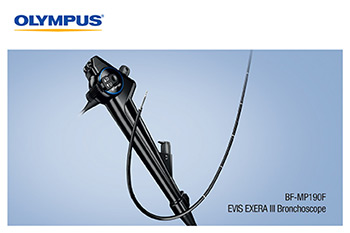Olympus Announces BF-MP190F Bronchoscope
The Ultra-Slim, Fully Rotatable Diagnostic Bronchoscope Expands Access to Smaller Airways and Distal Lesions, Extending Reach by Up to Two Additional Branches of the Lung

Olympus announced today the FDA clearance of its BF-MP190F, a fully rotatable, ultra-slim bronchoscope featuring an optimal ratio of working channel to outer diameter size, compatible with the radial endobronchial ultrasound (EBUS) probe and an array of sampling devices to expand access to smaller, more distal airways. The BF-MP190F’s ratio of a 1.7 mm working channel to 3.0 mm distal-end outer diameter provides pulmonologists with benefits during access, sampling and diagnosis of lung diseases such as cancer.
CENTER VALLEY, Pa., (July 23, 2018) – Olympus, a global technology leader in designing and delivering innovative solutions for medical and surgical procedures, among other core businesses, announced today the FDA clearance of its BF-MP190F, a fully rotatable, ultra-slim bronchoscope featuring an optimal ratio of working channel to outer diameter size, compatible with the radial endobronchial ultrasound (EBUS) probe and an array of sampling devices to expand access to smaller, more distal airways. The BF-MP190F’s ratio of a 1.7 mm working channel to 3.0 mm distal-end outer diameter provides pulmonologists with benefits during access, sampling and diagnosis of lung diseases such as cancer.
BF-MP190F benefits include:
- Advanced Maneuverability and Ease of Use: Fiber optics and placement of the video chip in the handle of the bronchoscope help free up space in the insertion tube and allow for a wider instrument channel, providing ultra-slim design that facilitates access to up to two branches beyond the previous bronchoscope’s accessible range. Insertion tube rotation of up to 120° left and right may effectively reduce hand rotation and supports easier insertion and positioning of endoscopic devices. The wide angulation range can be maintained even when an endoscopic device is inserted, making it easier to access difficult-to-reach peripheral areas of the lung. The waterproof one-touch connector minimizes the effort required for set up, and is fully submersible, eliminating the need for a water-resistant cap.
- Advanced Visualization: The BF-MP190F’s expanded reach, when used with proprietary Olympus radial EBUS probes, allows for real-time confirmation of the lesion location which can assist in targeted sampling.
- Advanced Versatility: With a 1.7mm working channel, the BF-MP190F is compatible with an array of Olympus diagnostic and sampling devices, including the radial EBUS probe, biopsy forceps, cytology brush, and the PeriView FLEX needle for transbronchial needle aspiration (TBNA). Equipment standardization made possible through the EVIS EXERA III processor platform allows facilities compatibility across multiple specialties and devices. Standardization of equipment, support and service help in meeting goals of lower total cost of equipment ownership.
"The ultra-slim profile of this bronchoscope may address some limitations to our current practices by improving accessibility to peripheral lesions without compromising our ability to use recommended tools such as the radial EBUS probe and transbronchial needle aspiration,” said Dr. Alexander Chen, Director, Interventional Pulmonology, Washington University in St. Louis, MO. "For these reasons, the BF-MP190F bronchoscope may be a valuable addition to assist in the diagnosis and management of peripheral pulmonary lesions."
“A goal of our innovation is to expand the capabilities of our physician customers,” said Kurt Heine, Group Vice President of the Endoscopy Division at Olympus America Inc. “The further into the body we can go with minimally invasive equipment, the more power we will have to diagnose disease earlier and more accurately, which can lead to combined benefits of reduced cost and improved patient outcomes and satisfaction.”
Lung cancer is the leading cause of cancer-related deaths in the U.S., according to the Centers for Disease Control, with more than 400 Americans each day dying from the disease. About 70-80 percent of cancers are diagnosed at the advanced stage when the survival rate is only 5 percent (defined as surviving for five or more years from diagnosis). Only 15 percent of patients are diagnosed in the early stage, when the survival rate is much more promising, at 55 percent.i
In July 2013, The U.S. Preventive Services Task Force (USPSTF) announced new recommendations for lung cancer screening for people at high risk for lung cancer, leading to increases in CT screening. Around the same time, the American College of Chest Physicians changed its lung cancer guidelines, now recommending Endobronchial Ultrasound over surgery for lung cancer staging. Many of these patients require follow-up care that could, by USPSTF estimates, prevent roughly 14 percent of the 160,000 lung cancer deaths each year. Recent CMS increases in reimbursement for procedures related to lung cancer diagnosis allow hospitals to more readily build their lung cancer program.
The Olympus BF-MP190F ultra-slim bronchoscope is part of the Olympus EBUS Solution family of products, designed to give bronchoscopists all they need to perform real-time lymph node and peripheral lesion sampling in one complete system.
For more information about the BF-MP190F, please call 1-800-848-9024 or visit us at http://medical.olympusamerica.com.
# # #
About Olympus Medical Systems Group
Olympus is a global technology leader, crafting innovative optical and digital solutions in medical technologies; life sciences; industrial solutions; and cameras and audio products. Throughout our nearly 100-year history, Olympus has focused on being true to society and making people’s lives healthier, safer and more fulfilling.
Our Medical Business works with health care professionals to combine our innovative capabilities in medical technology, therapeutic intervention, and precision manufacturing with their skills to deliver diagnostic, therapeutic and minimally invasive procedures to improve clinical outcomes, reduce overall costs and enhance quality of life for patients. For more information, visit medical.olympusamerica.com.
i Surveillance, Epidemiology, and End Results (SEER), 18 registries, National Cancer Institute, 2016.






























